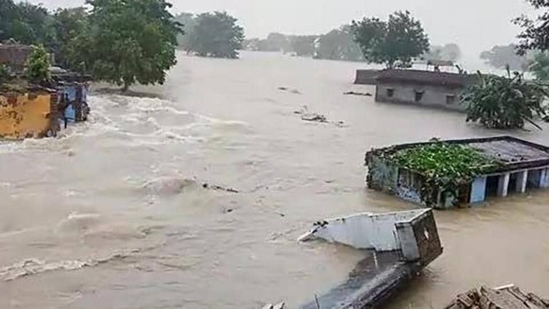Alert early, heed the warnings of nature
Despite a rash of urban floods, including in the Capital, the water is not above our heads yet. We can make cities climate resilient. Here’s how
As parts of Delhi were submerged when the Yamuna swelled to a record high, and Himachal Pradesh, Uttarakhand, Haryana and Punjab suffered massive floods, one thing was clear — erratic weather is here to stay in India. The cost of these increasing weather events has been heavy. One estimate, by the World Meteorological Organization, suggests that India suffered damages worth ₹62,000 crore due to extreme cyclone and flood events in 2021 alone. It is hard to be optimistic when water is threatening to go above our heads, literally and otherwise. But the game is not up and we still have a chance to make our cities more climate-resilient, safeguard lives and livelihoods and protect investments.

Early warning systems are the lowest hanging fruit. The India Meteorological Department (IMD) is now topping up its weather predictions with impact-based forecasts and risk warnings. About 10 million text alerts were sent out during Cyclone Biparjoy in Gujarat, alone.
So, how do we leverage technology better for India’s disaster preparedness? The etymology of the word comes from the Greek techne, meaning the art, craft or skill, and logia, meaning the study or systematic treatment of scientific methods. Technology, then, is not just a machine, app, or data, it is the art of how we leverage them for the common good. For India’s early warning systems — and sustainable urban development — this has six key implications: Forecasting, broadcasting, coordinating, investing, learning, and most importantly, listening.
First, there is the need to shift towards better forecasting and now-casting. It is worth noting India’s progress with multi-hazard early warning systems for cyclones. The Council on Energy Environment and Water (CEEW)’s latest report finds that 25% of Indians are exposed to cyclones, but early warnings are now available to the entire exposed population. Similar levels of access, availability and effectiveness are needed for flood alerts. But while 66% of Indians are now exposed to floods, only a third of those exposed are covered by early warnings. States such as Assam, Odisha, Sikkim, Uttarakhand, Jharkhand, and Kerala are showing the way. Deriving the right insights from the forecasting data to give real-time advice to people, institutions and agencies makes the information salient. While multi-hazard early warning systems — which can also alert about flooding and coastal storm surges — are in place for cyclones, there is a need to build institutional capacity for all extreme climate events, including urban flooding.
Secondly, broadcasting information but not giving in to sensationalism. If timely and accurate information is the logia, then the art is in communicating it correctly. The focus needs to be on alerting, not alarming. The Coalition for Disaster Resilient Infrastructure (CDRI) has telecommunications — a foundational infrastructure for early warnings — as a key pillar of its work. It doesn’t matter if everyone has a cellphone when the towers get damaged during a storm or flood. The art then is to use the social capital of trusted local voices to broadcast timely messages. For instance, in Uttarakhand’s Rudraprayag region, Mandakini ki Awaz, a community radio station, relays valuable information before, during and after climatic disasters.
Thirdly, coordinating effectively. Mumbai has built a good integrated command and control centre and Chennai is developing its own detailed flood management protocols. Similar efforts are needed across all major urban centres. Detailed flood risk assessments will need coordination across departments so that the impacts can be correctly estimated and seamless response mechanisms institutionalised.
The National Institute of Disaster Management has an important role in training officials. No major infrastructure should be sanctioned until climate-proofing is embedded in its investment plan and project report. We must build for rising risks in the future, not average risks measured from the past.
Fourthly, making an economic case for investing in disaster preparedness. A 2021 CEEW study found that 27 states and Union Territories are vulnerable to extreme hydromet disasters. So making a district disaster-resilient should be a precursor to inviting companies and industries to set up shop. Hiding our heads in the sand about vulnerabilities is not the way to attract investments. Instead, mapping vulnerabilities and investing in resilience can become a selling point for regions that are more geared up to keeping factories humming in a climate-changed world. The PM Gati Shakti programme must also embed resilience in multimodal freight connectivity infrastructure.
With its varied geography, interventions in one Indian region might not scale in others. Therefore, fifthly, we need not scale but the speed of learning lessons from successes and failures, and localising them for other areas. Moreover, leveraging existing networks on the ground, especially in rural and peri-urban areas, such as self-help groups, ASHA and anganwadi workers, can spread early warnings and mobilise community resources as first lines of defence.
Finally, listening to communities. We may have all the data and systems in place, but resilience must be built from the ground up. For instance, in Mumbai’s flood-prone Ambojwadi, residents built a first-response team and surveyed vulnerable areas so people are not caught off-guard during climate disasters. Such learnings can build a climate-resilient India on top of a solid base of data, science and technology.
A building going up or a road laid down looks attractive until it collapses. Sustainable development is not just about the environment; it’s also about an economy and society that thrives despite crises, rather than one that prospers while becoming more vulnerable to shocks. We must stop celebrating concrete and start investing in resilience.
Dr Arunabha Ghosh is CEO, CEEW, and a Commissioner for the Global Commission on the Economics of Water. The views expressed are personal
All Access.
One Subscription.
Get 360° coverage—from daily headlines
to 100 year archives.



HT App & Website







